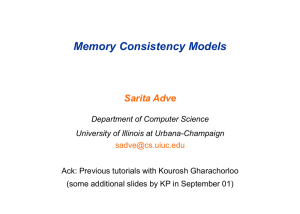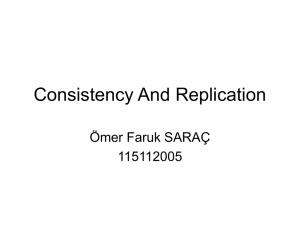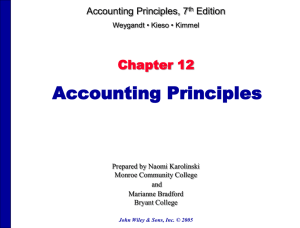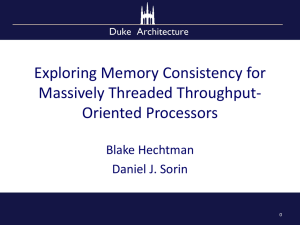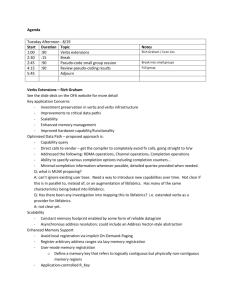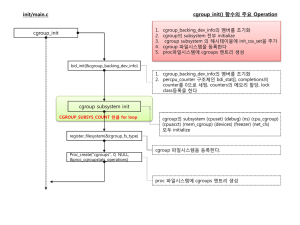ppt
advertisement
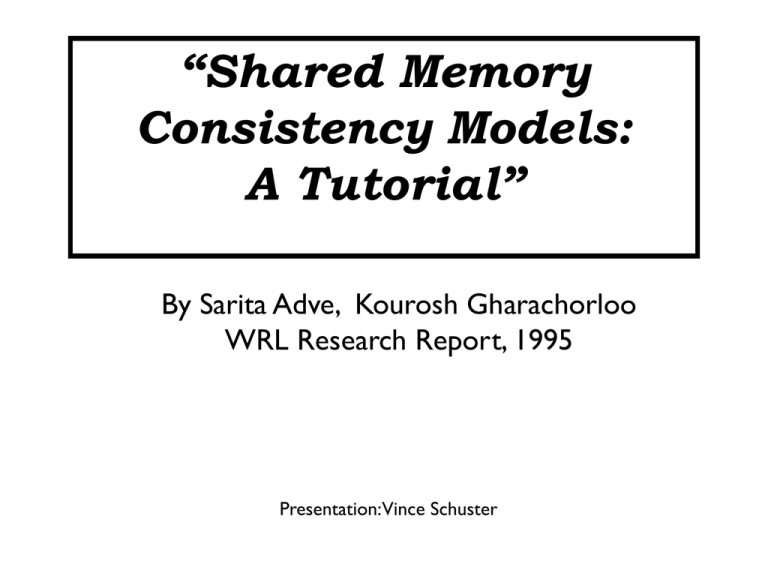
“Shared Memory
Consistency Models:
A Tutorial”
By Sarita Adve, Kourosh Gharachorloo
WRL Research Report, 1995
Presentation:Vince Schuster
Contents
Overview
Uniprocessor
Review
Sequential Consistency
Relaxed Memory Models
Program Abstractions
Conclusions
2
Overview
Correct & Efficient Shmem Programs
Require precise notion of behavior w.r.t. read (R) and write
(W) operations between processor memories.
Example 1, Figure 1
Initially, all ptrs = NULL; all ints = 0;
P1
While (no more tasks) {
Task = GetFromFreeList();
Task->Data = …;
insert Task in task queue
}
Head = head of task queue;
3
Q: What will Data be?
P2, P3, …, Pn
While (MyTask == null) {
Begin Critical Section
if (Head != null) {
MyTask = Head;
Head = Head->Next;
}
End Critical Section
}
… = MyTask->Data;
A: Could be old Data
Definitions
Memory Consistency Model
Formal Specification of Mem System Behavior to Programmer
Program Order
The order in which memory operations appear in program
Sequential Consistency (SC): An MP is SC if
Exec Result is same as if all Procs were in some sequence.
Operations of each Proc appear in this sequence in order specified by
its program. (Lamport [16])
Relaxed Memory Consistency Models (RxM)
An RxM less restrictive than SC. Valuable for efficient shmem.
System Centric: HW/SW mechanism enabling Mem Model
Programmer-centric: Observation of Program behavior a
memory model from programmer’s viewpoint.
Cache-Coherence:
A write is eventually made visible to all MPs.
Writes to same loc appear as serialized (same order) by MPs
NOTE: not equivalent to Sequential Consistency (SC)
1.
2.
4
UniProcessor Review
Only needs to maintain control and data dependencies.
Compiler can perform extreme Optz: (reg alloc, code motion, value propagation,
loop transformations, vectorizing, SW pipelining, prefetching, …
A multi-threaded program will look like:
T1
T2
T3
Memory
Conceptually, SC wants the one program
memory w/ switch that connects procs to
memory + Program Order on a perProcessor basis
5
T4
...
Tn
All of memory will appear to have the
same values to the threads in a
UniProcessor System. You still have to
deal with the normal multi-threaded
problems by one processor, but you don’t
have to deal with issues such as Write
Buffer problems or Cache Coherence.
Seq. Consist. Examples
P1 // init: all = 0
P2 // init: all = 0
Flag1 = 1
Flag2 = 1
If (Flag2 == 0)
If (Flag1 == 0)
critical section
critical section
Dekker’s Algorithm:
What if Flag1 set to 1 then
Flag2 set to 1 then ifs? Or
F2 Read bypasses F1 Write?
A: Sequential Consistency
(program order & Proc seq)
P1
P2
P3
A = 1
If (A == 1)
B = 1
If (B == 1)
reg1 = A
6
What if P2 gets Read of A
but P3 gets old value of A?
A: Atomicity of memops
(All procs see instant and
identical view of memops.)
NOTE: UniProcessor system doesn’t have to deal with
old values or R/W bypasses.
Architectures
Will visit:
Architectures w/o Cache
Write Bufferes w/ Bypass Capability
Overlapping Write Operations
Non-Blocking Read Operations
Architectures w/ Cache
7
Cache Coherence & SC
Detecting Completion of Write Operations
Illusion of Write Atomicity
Write Buffer w/ Bypass Capability
P1
Read
Flag2
t1
P2
Write Flag1 t3
Read
Flag1
t2
Write Flag2 t4
Bus-based Mem
System w/o
Cache
• Bypass can hide Write latency
• Violates Sequential Consistency
Q: What happens if
NOTE: Write Buffer not
Read of Flag1 & Flag2
a problem on
UniProcessor Programs
bypass Writes?
Shared Bus
Flag1: 0
Flag2: 0
A: Both enter
critical section
8
P1 // init: all = 0
P2 // init: all = 0
Flag1 = 1
Flag2 = 1
If (Flag2 == 0)
If (Flag1 == 0)
critical section
critical section
Overlapping Writes
P1
P2
Read Data t3
Read Head t2
Write Head
t1
Write Data
t4
Memory
Head: 0
A: Data Read
returns 0
Data: 0
• Interconnection network
alleviates the serialization
bottleneck of a bus-based
design. Also, Writes can be
coalesced.
Q: What happens if
Write of Head bypasses
Write of Data?
P1 // init: all = 0
P2 // init: all = 0
Data = 2000
Head = 1
While (Head == 0) ;
... = Data
9
Non-Blocking Reads
P1
P2
Interconnect
Write Head t3
Write Data t2
Read Head
t4
Read Data
t1
Memory
Head: 0
A: Data Read
returns 0
10
Non-Blocking Reads Enable
• non-blocking caches
• speculative execution
• dynamic scheduling
Data: 0
Q: What happens if
Read of Data bypasses
Read of Head?
P1 // init: all = 0
P2 // init: all = 0
Data = 2000
Head = 1
While (Head == 0) ;
... = Data
Cache-Coherence & SC
Write buffer w/o cache
Cache-Coherence:
1.
2.
3.
Write-thru cache
Reads can proceed before Write completes (on other MPs)
similar to
not equiv to Sequential Consistency (SC)
A write is eventually made visible to all MPs.
Writes to same loc appear as serialized (same order) by MPs
Propagate value via invalidating or updating cache-copy(ies)
Detecting Completion of Write Operation
What if P2 gets new Head but old Data?
Avoided if invalidate/update before 2nd Write
Write ACK needed
Or at least Invalidate ACK
P1
P2
Read Data t3
Read Head t2
Write Head
Write Data
t1
t4
Write-thru cache
Head: 0
Memory
11
Data: 0
Memory
Illusion of Write Atomicity
Cache-coherence Problems:
Cache-coherence (cc) Protocol must propogate value to all copies.
Detecting Write completion takes multi ops w/ multiple replications
Hard to create “Illusion of Atomicity” w/ non-atomic writes.
1.
2.
3.
Q: What if P1 & P2 updates reach P3 & P4 differently?
A: Reg1 & Reg2 might have different results (& violates SC)
Solution:
Can serialize writes to same location
Alternative: Delay updates until ACK of previous to same loc
Still not equiv to Sequential Consistency.
P1:
A=B=C=0
A = 1
B = 1
12
P2 = 0
P3
P4
A = 2
C = 1
While (B != 1) ;
While (C != 1) ;
Reg1 = A
While (B != 1) ;
While (C != 1) ;
Reg2 = A
Ex2: Illusion of Wr Atomicity
Q: What if P2 reads new A before P3 gets updated w/ A;
AND P2 update of B reaches P3 before its update of A
AND P3 reads new B & old A?
A: Prohibit read from new value until all have ACK’d.
Update Protocol (2-phase scheme):
1. Send update, Recv ACK from each MP
2. Updated MPs get ACK of all ACKs.
(Note: Writing proc can consider Write complete after #1.)
P1
A = 1
13
P2
If (A == 1)
B = 1
P3
If (B == 1)
reg1 = A
Compilers
Compilers do many optz w.r.t. mem reorderings:
CSE, Code motion, reg alloc, SW pipe, vect temps, const prop,…
All done from uni-processor perspective. Violates shmem SC
e.g. Would never exit from many of our while loops.
Compiler needs to know shmem objects and/or
Sync points or must forego many optz.
14
Sequential Consistency
Summary
SC imposes many HW and Compiler constraints
Requirements:
1.
2.
3.
Discuss HW Techniques useful for SC & Efficiency:
Complete of all mem ops before next (or Illusion thereof)
Writes to same loc need be serialized (cache-based).
Write Atomicity (or illusion thereof)
Pre-Exclusive Rd (Delays due to Program Order); cc invalid mems
Read Rolebacks (Due to speculative exec or dyn sched).
Global shmem data dep analysis (Shasha & Snir)
Relaxed Memory Models (RxM) next
15
Relaxed Memory Models
Characterization (3 models, 5 specific types)
1a. Relax Write to Read program order (PO)
1b. Relax Write to Write PO
(assume
different
locations)
1c. Relax Read to Read & Read to Write POs
Relaxation
2. Read others’ Write early
(most allow & usually safe; but
what if two writers to same loc?)
• Some RxMs can be detected by programmer, others not.
• Various Systems use different fence techniques to provide safety nets.
• AlphaServer, Cray T3D, SparcCenter, Sequent, IBM 370, PowerPC
3. Read own Write early
16
(cache-based only)
Relaxed Write to Read PO
Relax constraint of Write then Read to a diff loc.
Reorder Reads w.r.t. previous Writes w/ memory disambiguation.
3 Models handle it differently. All do it to hide Write Latency
Only IBM 370 provides serialization instr as safety net between W&R
TSO can use Read-Modify-Write (RMW) of either Read or Write
PC must use RMW of Read since it uses less stringent RMW requirements.
P1
F1
A
Rg1
Rg2
P2
=
=
=
=
Rslt:
1
1
A
F2
F2
A
Rg3
Rg4
P1
=
=
=
=
1
2
A
F1
Rg1 = 1, Rg3 = 2
Rg2 = Rg4 = 0
• TSO & PC since they allow
Read of F1/F2 before Write of
F1/F2 on each proc
17
P2
P3
A = 1
if(A==1)
B = 1
if (B==1)
Rg1 = A
Rslt:
Rg1 = 0, B = 1
• IBM 370 since it allows P2 Read of new
A while P3 Reads old A
Relaxing W2R and W2W
SPARC Partial Store Order (PSO)
Writes to diff locs from same proc can be pipelined or overlapped and
are allowed to reach memory or other caches out of program order.
PSO == TSO w.r.t. letting itself read own write early and prohibitting
others from reading value of another proc’s write before ACK from all.
W2R: Decker’s Algorithm – PSO will still allow non-SC rslts
P1 // init: all = 0
P2 // init: all = 0
Flag1 = 1
If (Flag2 == 0)
critical section
Flag2 = 1
If (Flag1 == 0)
critical section
W2W: PSO Safety net is to provide STBAR (store barrier)
18
P1 // init: all = 0
P2 // init: all = 0
Data = 2000
STBAR
// Write Barrier
Head = 1
While (Head == 0) ;
... = Data
Relaxing All Program Order
R or W may be reordered w.r.t. R or W to diff location
Can hide latency of Reads in the context of either static or dynamic
(out-of-order) scheduling processors (can use spec exec & nonblocking caches).
Alpha, SPARC V9 RMO, PowerPC
SPARC & PPC allow reorder of reads to same location.
Violate SC for previous codes (let’s get dangerous!)
All allow a proc to read own write early but:
RCpc and PPC allow a read to get value of other MP Wr early (complex)
Two catagories of Parallel program semantics:
1.
2.
Distinguish MemOps based on type (WO, RCsc, RCpc)
Provide explicit fence capabilities (Alpha, RMO, PPC)
19
Weak Ordering (WO)
Two MemOp Catagories: 1) Data Ops 2) Sync Ops
Program order enforced between these
Programmer must ID Sync Op (safety net) – counter utilized (inc/dec)
Data regions between Sync Ops can be reordered/optimized.
Writes appear atomic to programmer.
20
Release Consistency (RCsc/RCpc)
• RCsc: Maintains SC among special ops
• Constraints: acquire all; all release; special special
• RCpc: Maintains Processor Consistency among special ops; W R
program order among special ops eliminated.
• Constraints: acquire all; all release; special special
• except special WR special RD
shared
special
• RMW used to maintain Program Order
• subtle details
sync
21
acquire
ordinary
nsync
release
Alpha,RMO,PPC
Alpha: fences provided
SPARC V9 RMO: MEMBAR fence
MB – Memory Barrier
WMB- Write Memory Barrier
Write atomicity fence not needed.
bits used for any of R W; W W; R R; W R
No need for RMW.
Write atomicity fence not needed.
PowerPC: SYNC fence
Similar to MB except:
Write Atomicity may require RMW
22
R R to same location can still be OoO Exec (use RMW)
Allows write to be seen early by another processor’s read
Abstractions
Generally, compiler optz can go full bore between
sync/special/fence or sync IDs.
Some optz can be done w.r.t. global shmem objects.
Programmer supplied, standardized safety nets.
“Don’t know; Assume worst” – Starting method?
Over-marking SYNCs is overly-conservative
Programming Model Support
doall – no deps between iterations –(HPF/F95 – forall, where)
SIMD (CUDA) – Implied multithread access w/o sync or IF cond
Data type - volatile - C/C++
Directives – OpenMP: #pragma omp parallel Sync Region
#pragma omp shared(A) Data Type
Library – (eg, MPI, OpenCL, CUDA)
23
Using the HW & Conclusions
Compilers can
protect memory ranges [low…high]
Assign data segments to protected page locations
Use high-order bits for addrs of VM
Extra opcode usage (eg, GPU sync)
Modify internal memory disambiguation methods
Perform Inter-Procedural Optz for shmem optz.
Relaxed Memory Consistency Models
+ Puts more performance, power & responsibilities
into hands of programmers and compilers.
- Puts more performance, power & responsibilities
into hands of programmers and compilers.
24
The End
